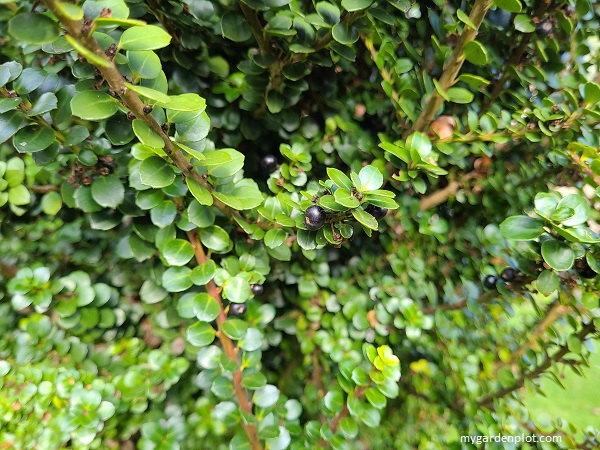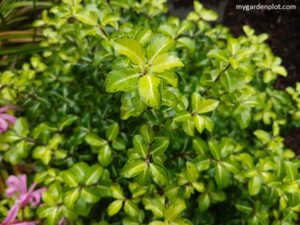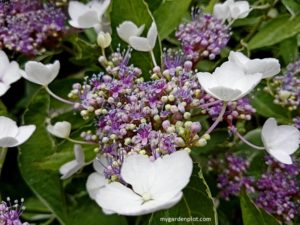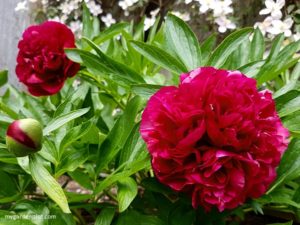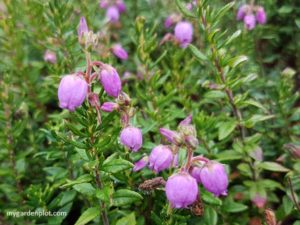About Ilex crenata: Evergreen Japanese Holly (also referred to as Box Leaf Holly and Sky Pencil Holly)
The Ilex crenata, or more commonly known as Japanese holly, is often confused with boxwood. Though the foliage is similar, the evergreen Japanese holly is a member of the Ilex (holly) family. It is frost hardy, low maintenance and slow-growing. It has small, glossy leaves, tiny white flowers, and the female plant bears small black berries. The flowers do not have a fragrance but bees are attracted to it.
There are various recommended Japanese holly cultivars ranging in size from small to large (more details below).
The Ilex crenata is native to Japan, Korea, China and Russia. Many cultivars are suitable for container gardening and they are a great alternative to boxwood shrubs in a planter. The name ‘Japanese holly’ is also used for the Ilex serrata species, a deciduous shrub of the holly family.
By following these care and pruning guidelines, your Ilex crenata (Japanese holly) will maintain its health, shape, and density effectively.
How To Tell The Difference Between Japanese Holly And Boxwood
The evergreen Japanese holly and the boxwood look very similar, and it is sometimes hard to tell the difference. Both are evergreens and thrive in similar growing conditions. Their growth rate is slow, and their tolerance to hard pruning is the same. So how to tell the difference between Ilex crenata (Japanese holly) and Buxus (boxwood)?
For one, the Japanese holly has black berries and the boxwood does not produce berries.
They both have tiny inconspicuous flowers, but keep in mind the Japanese holly is dioecious, which means a plant is either male or female. Both are needed for pollination, and for the female Japanese holly to produce the small black berries. The boxwood shrub is not a dioecious plant.
The leaves of the Japanese holly are arranged alternate to each other while the boxwood leaves grow opposite each other and are perfectly smooth edged. The leaves of some of the Japanese hollies have very slightly scalloped edges.
The Japanese holly is somewhat hardier than the boxwood and more resistant to pests and diseases. It is the perfect option if you are looking for something to replace boxwood shrubs.
Ilex crenata (Japanese Holly) At A Glance
Type: Evergreen Shrub
Location: Full Sun / Part Shade
Seasonal Interest: Year-round Foliage / Spring Flowers / Autumn And Winter Berries
Height: Varies 0.5 – 3 metres (2 – 10 ft)
When To Prune: Late Winter / Early Spring (before new growth emerges, after the last frost)
Cold Hardiness Zones: 5, 6, 7, 8, 9
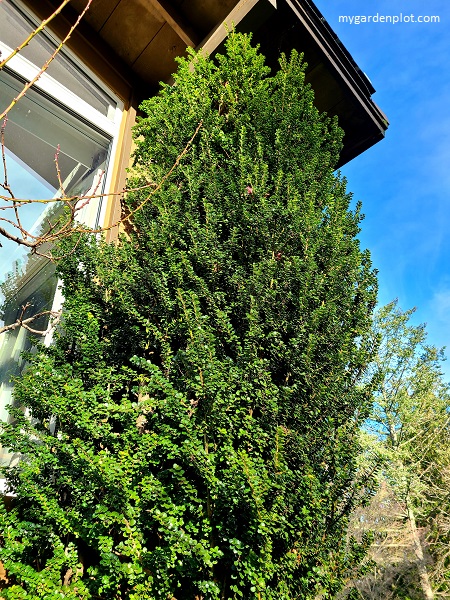
Where To Plant Ilex crenata (Japanese Holly)
The Japanese holly can be grown easily in the sun or part shade in most locations. In colder regions, plant in a sheltered area away from drying winter wind. They thrive in moderately fertile, moist, well-drained soil. The Japanese holly root system is not invasive and can safely be grown near the house.
How To Grow And Care Ilex crenata (Japanese Holly)
In spring feed with fertilizer formulated for acid-loving plants, like camellias, rhododendrons and azaleas. Japanese hollies may be labelled as drought-tolerant, however it is healthier with regular weekly watering, especially during hot summer spells.
How and When to Prune Ilex crenata (Japanese Holly)
Like most in the holly family, Japanese hollies benefit from some routine pruning to keep their shape and stay healthy. First identify if there are any dead, diseased, or crossing branches. Plan cuts to maintain the desired shape (e.g., natural shrub, hedge, or topiary). With careful planning they can tolerate hard pruning if needed and, although somewhat more expensive, can be excellent as hedging shrubs. Compact varieties (e.g., ‘Compacta’) may require less frequent pruning.
Late winter and early spring is the best time to prune a Japanese holly, especially for major pruning. This gives time for any new growth to harden off before winter and minimizes stress. Remove 1-2 older stems annually to improve airflow and light penetration. Focus on crowded areas to reduce disease risk. A healthy Japanese holly can tolerate cutting back to 6–12 inches in late winter. For less healthy plants this can be stressful and may take years to recover. Rejuvenation pruning for gradual renewal with an overgrown holly, plan it to be done over 3 years, by removing 1/3 of the oldest stems annually.
Most young Japanese hollies can benefit from light pruning to encourage a bushy form as they mature.
Light pruning for maintenance to shape or tidy up a mature healthy holly can be done late Spring to early Summer (after the first flush of growth). Avoid late summer or fall pruning to prevent tender new growth from winter damage.
Exceptions to this rule – dead, diseased, or damaged branches can be removed any time of year. Cut dead or diseased branches back to healthy wood or the base. Always disinfect tools with rubbing alcohol or a 10% bleach solution to prevent disease spread.
Post-pruning care should include watering thoroughly and a light fertilization application to encourage recovery.
Shaping Techniques:
For a natural Look, make selective cuts just above leaf nodes or buds, trimming branches to varying lengths. For formal hedges or topiary, shear lightly, maintaining a tapered shape (wider at the base) for even sunlight.
Key Tips:
Avoid cutting into leafless old wood, and avoid over-pruning. Never remove more than 1/3 of the plant in a single year. Prune on dry days to reduce disease risk. Timing your pruning will minimize stress and allow your Japanese holly to recover during the growing season.
RELATED TOPIC: Buyer’s Guide On How To Choose Hand Pruners (Secateurs)
Tools Needed For Pruning Ilex crenata (Japanese Holly)
Below is the list of essential tools needed to prune a Japanese holly shrub. Remember to keep tools sharp and clean, and to wipe blades with alcohol or a 10% bleach solution between cuts if disease is suspected.
- Pruners – Bypass pruners are the most popular choice for gardeners and a must in a pruner’s tool kit. Bypass means the blades pass each other in a scissorlike action providing a clean cut without splintering the stem’s edge. The anvil-type pruner, where the upper blade cuts against a lower flat edge, must always be kept sharp. Otherwise, it will crush the stem while trying to cut it.
- Long-handled Loppers – These are similar to pruners but with long handles. These are heavy-duty and great for harder to reach stems and branches that may also be too thick for pruners. Loppers with extendable handles offer that extra reach.
- Pruning Saw – Saws are useful for thick stems that are growing close together. A Grecian saw or Japanese-blade pruning saw is a handsaw with a curved edge that works with a pull-stroke action. Great for those stems that pruners and loppers can’t cut. It will need a protective case. We also recommend a folding hand saw with a pull-stroke action for smaller gardens. It looks similar to a large pocket knife and works in the same manner as a Grecian saw.
- Hedging Shears – You will need a standard pair of shears for trimming the ends, mainly with hedging and topiary. Some shears have a notch at the base of the blade that enables cutting thicker stems.
- Garden Gloves – Gardening gloves help keep hands clean and provide protection. Fabric gloves with vinyl offer a good grip on the fingers and palm. Good for warmer weather. For more challenging jobs, a pair of suede or leather gloves go a long way. Not too comfortable in warmer weather, though.
RELATED TOPIC: Buyer’s Guide On How To Choose A Pruning Saw
Pests And Diseases That Affect Ilex crenata (Japanese Holly)
The Japanese holly is generally disease and pest resistant, though some can be affected by spider mites. Most varieties are deer resistant. With our tall mature Sky Pencil holly, small birds like to settle in for nesting during spring and summer.
Recommended Evergreen Japanese Hollies
I. crenata (Japanese Holly) ‘Compacta’ – Also commonly known as ‘Compact Japanese holly’. It has a rounded habit that can reach up to 1.8 metres (6 ft) with equal spread forming a dense and attractive shape. Little pruning is needed to keep its rounded form. Foliage is glossy green.
I. crenata (Japanese Holly) ‘Convexa’ – The Japanese holly ‘Convexa’ also has a rounded habit as the ‘Compacta’ but it is about 30 cm (12 inches) smaller. It is also sometimes called ‘Convex-Leaved Japanese holly due to how the roundish leaves cup downward. This dense shrub works well with heavy pruning for hedges and topiary. It also tolerates drought, poor soil conditions and can withstand urban pollution. Best planted in a partially shady location.
I. crenata (Japanese Holly) ‘Golden Gem’ – It is a compact, bushy shrub and a spreading habit. Grows up to 1 metre (3 ft) tall with equal spread if not pruned. Great for low hedges and ideal for topiary. The foliage is green with speckled yellow-gold colour. ‘Golden Gem’ is a male cultivar, with only a few flowers and no berries.
I. crenata (Japanese Holly) ‘Helleri’ – This is a female cultivar with a rounded, dense, dwarf form that slowly grows to 1 metre (3 ft) tall and 1.2 m (4 ft) wide. It prefers rich, acidic soil and is not drought tolerant. Best for zones 7-9, where it can survive for about 40 years.
I. crenata (Japanese Holly) ‘Hetzii’ – The ‘Hetzii’ is similar to the ‘Convexa’ above but with larger leaves. Growth rate is a little faster than other Japanese hollies. It has a dwarf form, and at maturity, it’s rounded habit can form to just over .5 metres (2 ft).
I. crenata (Japanese Holly) ‘Lemon Gem’ – The ‘Lemon Gem’ is similar to the ‘Helleri’ above but with lime-green foliage. New leaves are yellowish in spring, turning to lime green in summer.
I. crenata (Japanese Holly) ‘Mariesii’ – A very slow-growing variety with a dense columnar (horizontal branching) form. Grows to about 60 cm (24 inches) in 10 years. Leaves are roundish and dark green. Great for containers, bonsai and rock gardens.
I. crenata (Japanese Holly) ‘Rotundifolia’ – This is a male cultivar that can grow to 3 metres (10 ft) tall with a broad, dense spread equal to its height. Foliage is dark green. The growth rate is very slow. If you have room for it in your garden, it can be impressive.
I. crenata (Japanese Holly) ‘Sky Pencil’ – The ‘Sky Pencil’ or pencil holly is one of the most popular Japanese hollies for gardens. It is similar in its dense columnar form to the ‘Mariesii’ but taller. The ‘Sky Pencil’ can reach over 3 metres (10 ft) and about 60 cm (24 inches) wide, and its growth rate is slow. Its height and unique narrow columnar habit add interest to a garden. The Japanese holly ‘Sky Pencil’ is a female cultivar.

